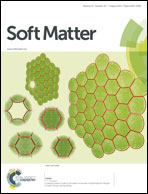Monte-Carlo simulations of PAMAM dendrimer–DNA interactions
Abstract
We use Monte Carlo simulations to determine the influence of poly(amido amine) (PAMAM) dendrimer size and charge on its interactions with double-stranded DNA conformation and interaction strength. To achieve a compromise between simulation speed and molecular detail, we combine the coarse-grained DNA model of de Pablo et al. which resolves each DNA base using three beads – and thereby retains the double-helix structure – with a dendrimer model with resolution similar to that of the DNA. The resulting predictions of the effects of dendrimer generation, dendrimer surface charge density, and salt concentration on dendrimer–DNA complexes are in agreement with both experiments and all-atom MD simulations. The model predicts that DNA wraps a fully charged G5 or G6 dendrimer at low salt concentration (10 mM) similarly to a histone octamer, and for the G5 dendrimer, DNA super helices with both handednesses occur. At salt concentrations above 50 mM, or when a high fraction of dendrimer surface charges are neutralized by acetylation, DNA adheres but does not compactly wrap the dendrimer, in agreement with experimental findings. We are also able to simulate pairs of dendrimers binding to the same DNA strand. Thus, our mesoscale simulation not only elucidates dendrimer–DNA interactions, but also provides a methodology for efficiently simulating chromatin formation and other cationic macroion–DNA complexes.


 Please wait while we load your content...
Please wait while we load your content...